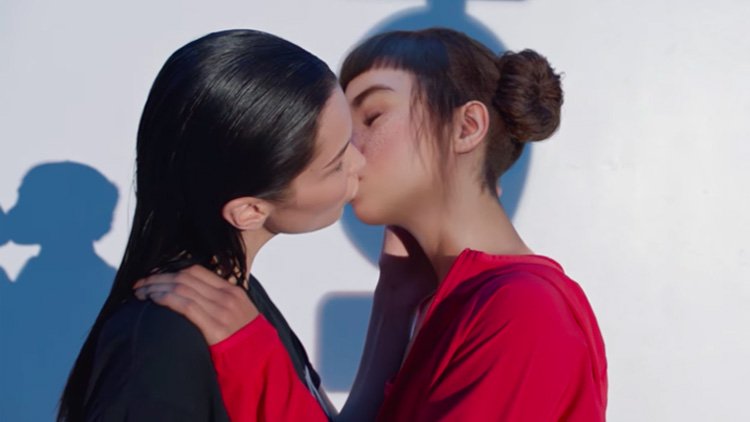The Toxicity of Queerbaiting
Bella Hadid, a heterosexual identifying woman, kissing a female-presenting robot, for an advertisement, which was later determined as queerbaiting by the general public since Hadid is not LGBTQ+. (Pride.com)
December 16, 2019
Long held eye-contact. Winking. Hand-holding. Kissing. All these chemistry-sparking moments in TV or movies would naturally lead the audience to anticipate a blossoming relationship. Quite often, this expectation is fulfilled. The two main characters find themselves drawn to each other with an electric connection. In the end, the guy gets the girl, and they’re swept into a glorious, whirlwind romance.
However, all too often, the classic hints of romance end up fizzling out into nothing when it comes to LGBTQ+ relationships. These cases of queerbaiting leave LGBTQ+ viewers lacking representation and not being able to identify with the relationships they see in the media.
Queerbaiting is the occurrence of TV and movie producers hinting at the presence of LGBTQ+ characters but never actually embracing or representing said characters. This tactic is done to draw in a LGBTQ+ audience to the TV show to improve viewership. Networks often use this lingering hope of queer characters and relationships as just enough to keep LGBTQ+ audiences engaged. These audiences remain optimistic producers will eventually follow through and give representation. However, this follow through is a rare occurrence. For instance, according to GLAAD’s “Where We Are on TV” report for the 2018 television, only 8.8% of regularly appearing characters on broadcast scripted primetime television were identified as LGBTQ+.
Part of the rationale behind queerbaiting is to gain viewership without alienating their main audience or experiencing backlash from a viewership that would not like to watch LGBTQ+ characters. This allows creators to widen their audience without diminishing it due to negative reaction.
Emily Jae Simpson, a Boise High Junior and S.A.G.A. club member, would personally like to see more LGBTQ+ representation; however, she understands that many producers, “don’t always have many LGBTQ+ characters because in some places it’s a controversial topic. They don’t want to lose views because of people that don’t agree with it.”
However, should media creators hint at LGBTQ+ characters if they don’t ever plan to give some form of representation?
Due to the commonality of queerbaiting, LGBTQ+ viewers often tune into TV shows with queer subtext in hopes that it isn’t the usual fake out. Thus, a cycle is created that allows media creators to continue to lure in viewers with false promises of an LGBTQ+ narrative, and this pattern of queerbaiting has become a common trend in television.
The frequent occurrence of queerbaiting is deeply harmful to the LGBTQ+ community. It denies proper representation. This denial can create the idea that queer individuals are second-rate characters, and they are unworthy of being given a legitimate story line. It can be disappointing for LGBTQ+ viewers to see their existence be diminished to mere implications.
Being portrayed in the media is an unexpectedly powerful thing. Queer people can be empowered by being able to relate to the characters they see in TV and movies. The coming out process as well as dealing with the internal and external struggles of sexuality and gender can be very challenging things to go through alone. However, showing relatable LGBTQ+ characters can give those struggling something to relate to. It will help them feel less alone and navigate these rocky waters.
Proper representation is also a strong way to normalize the existence of queer people in our day to day lives. “Since there isn’t a lot of representation now, it’d be good for people who don’t agree with it, so they could watch and maybe get a better idea (of LGBTQ+ challenges),” said Simpson. “It could be good to change people’s opinions.”
While representation is currently defined through queerbaiting, as a society, we should work towards pushing for legitimate representation. LGBTQ+ individuals deserve to see themselves accurately depicted in the media.



